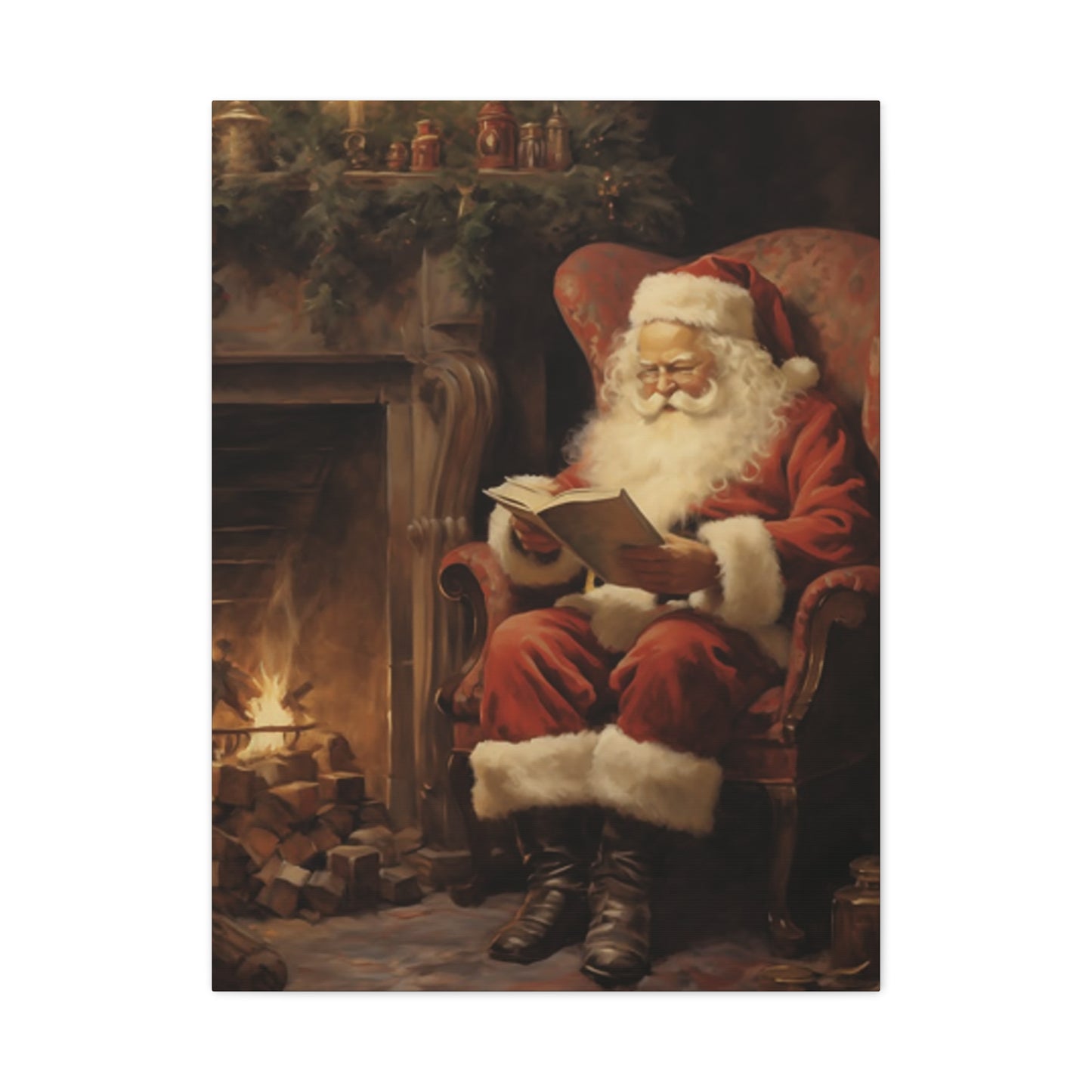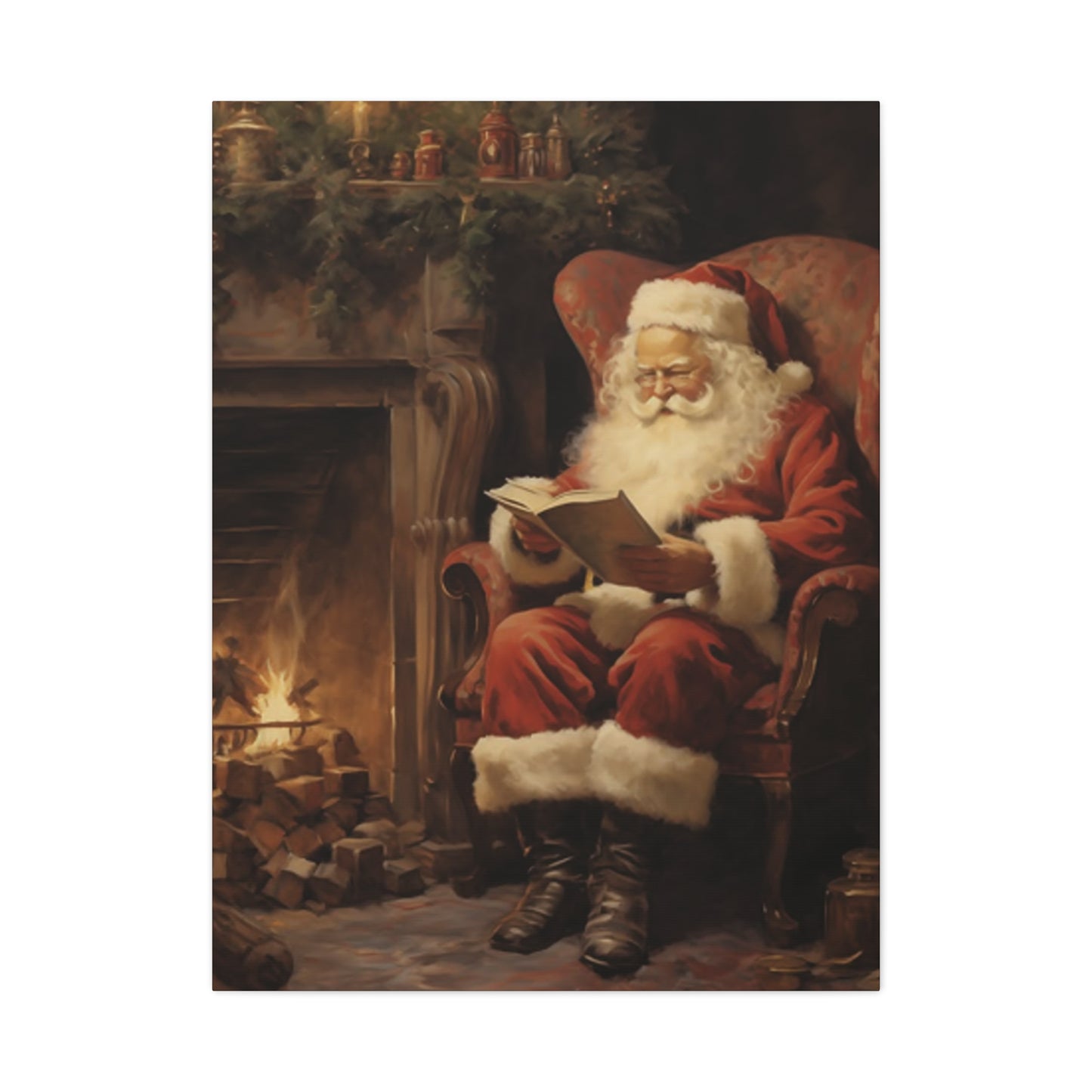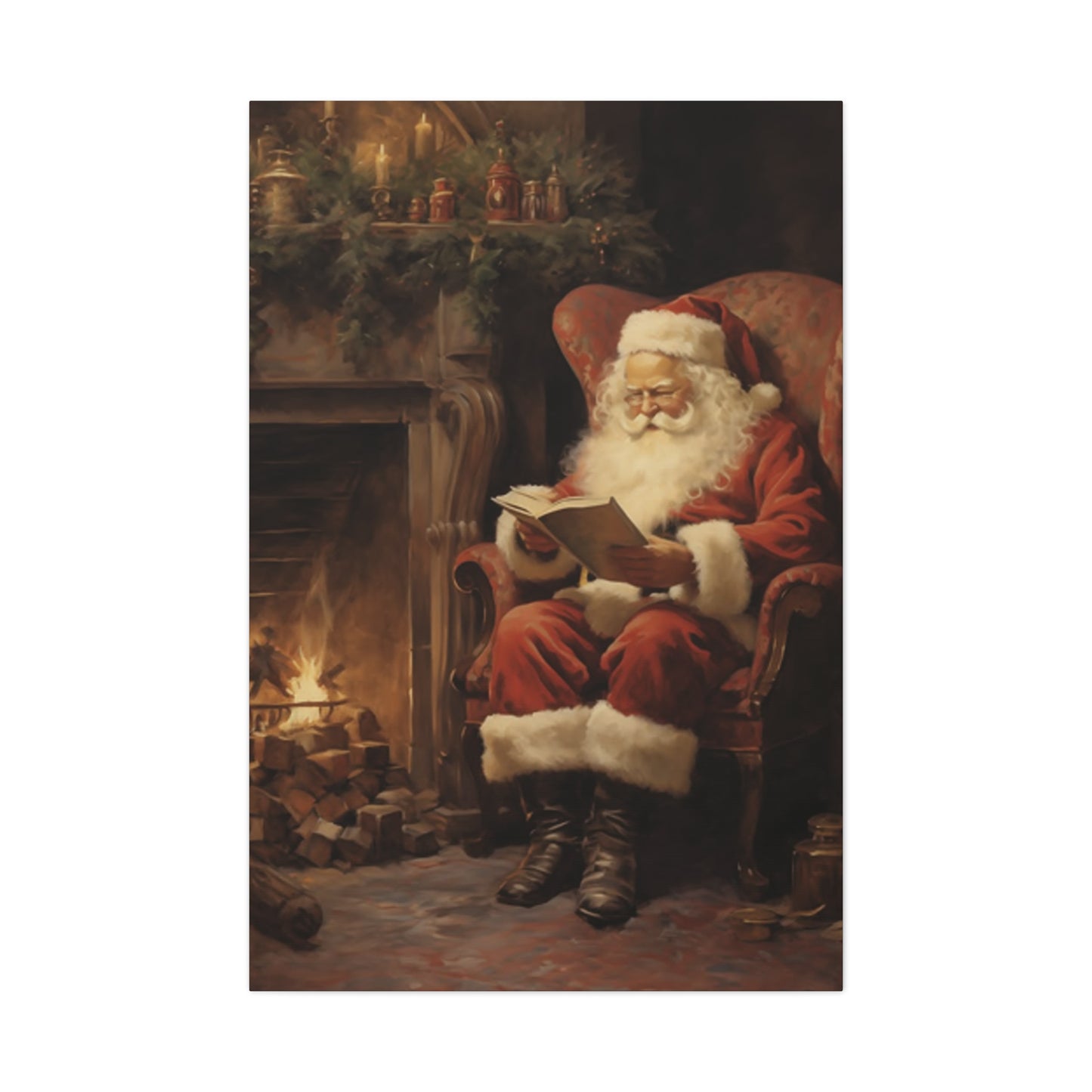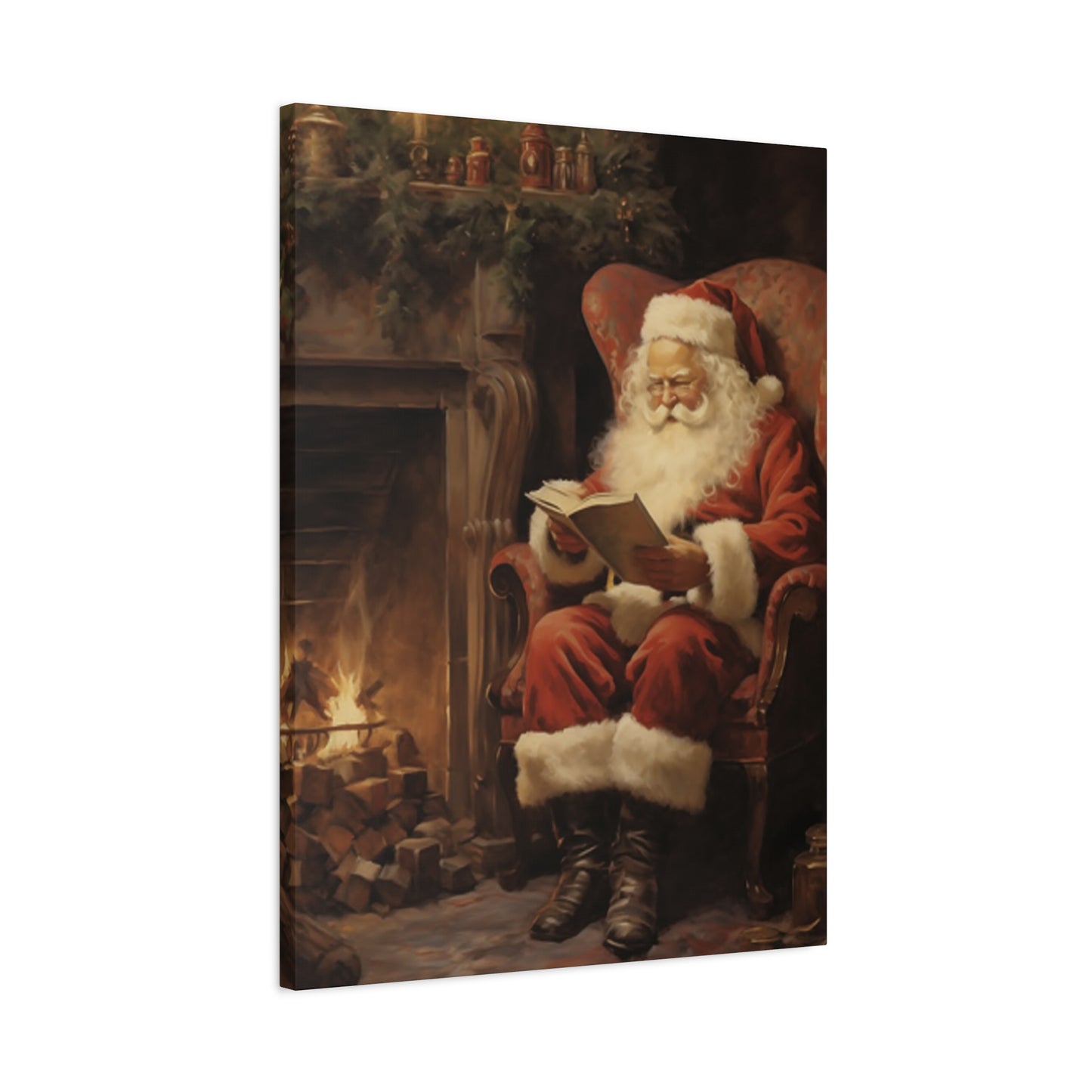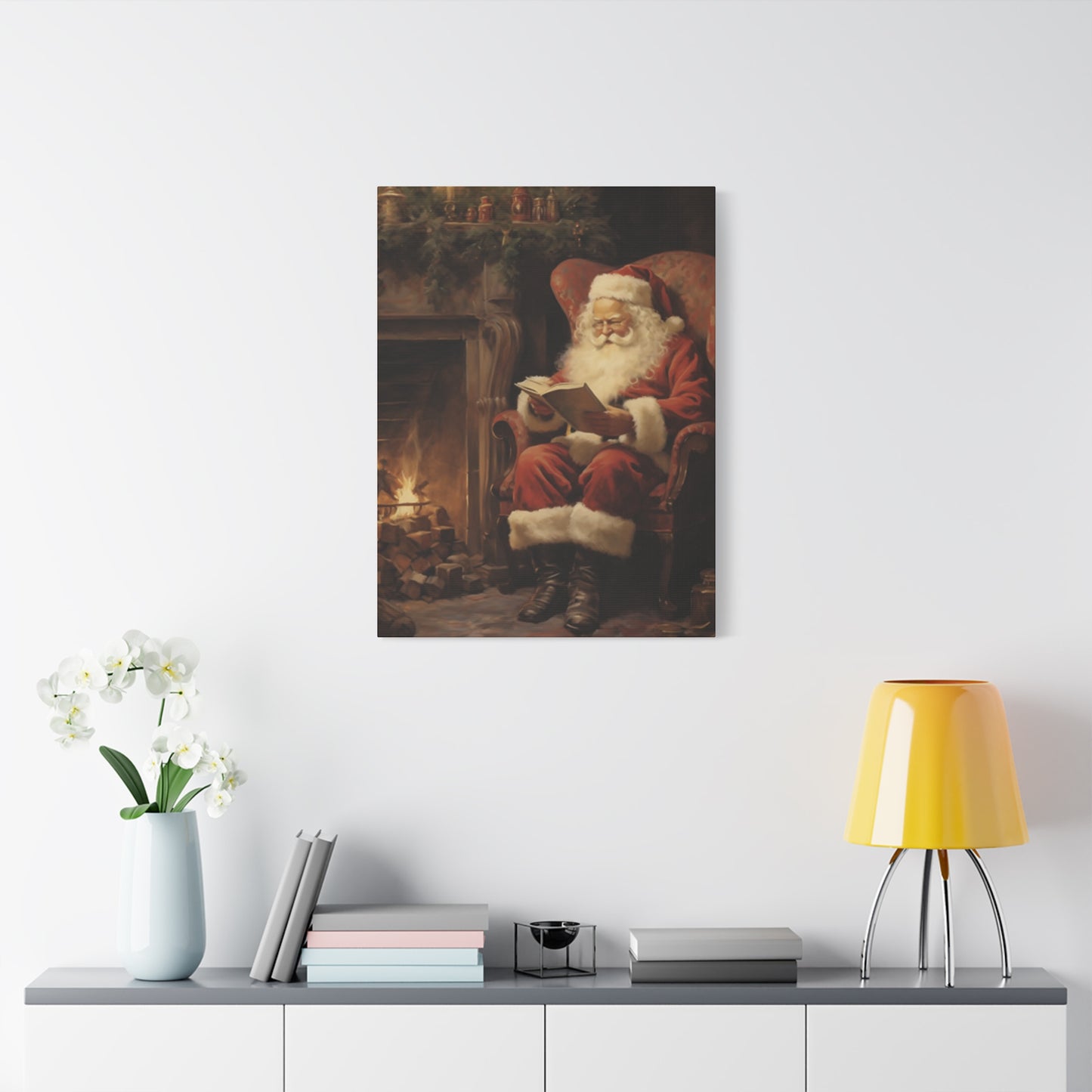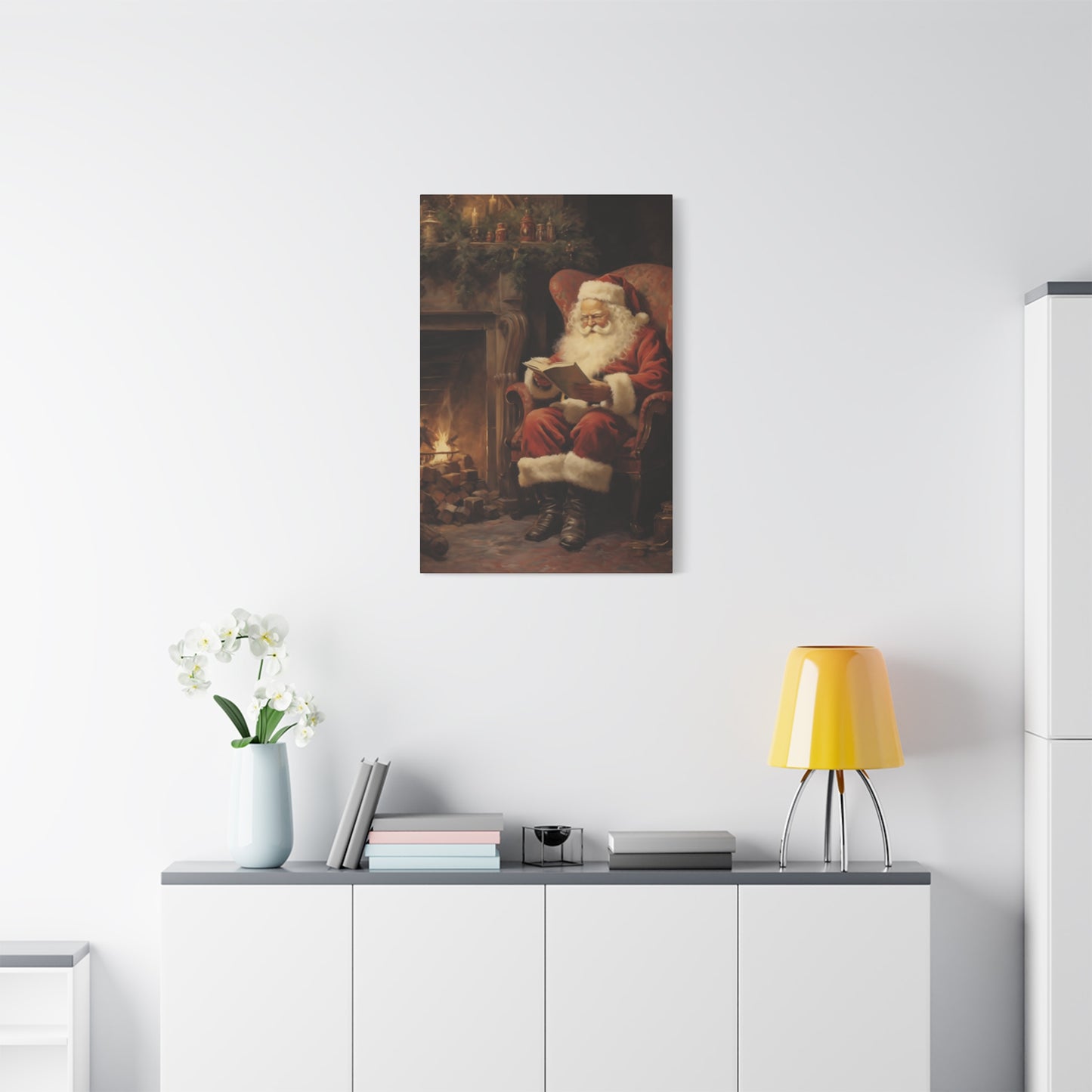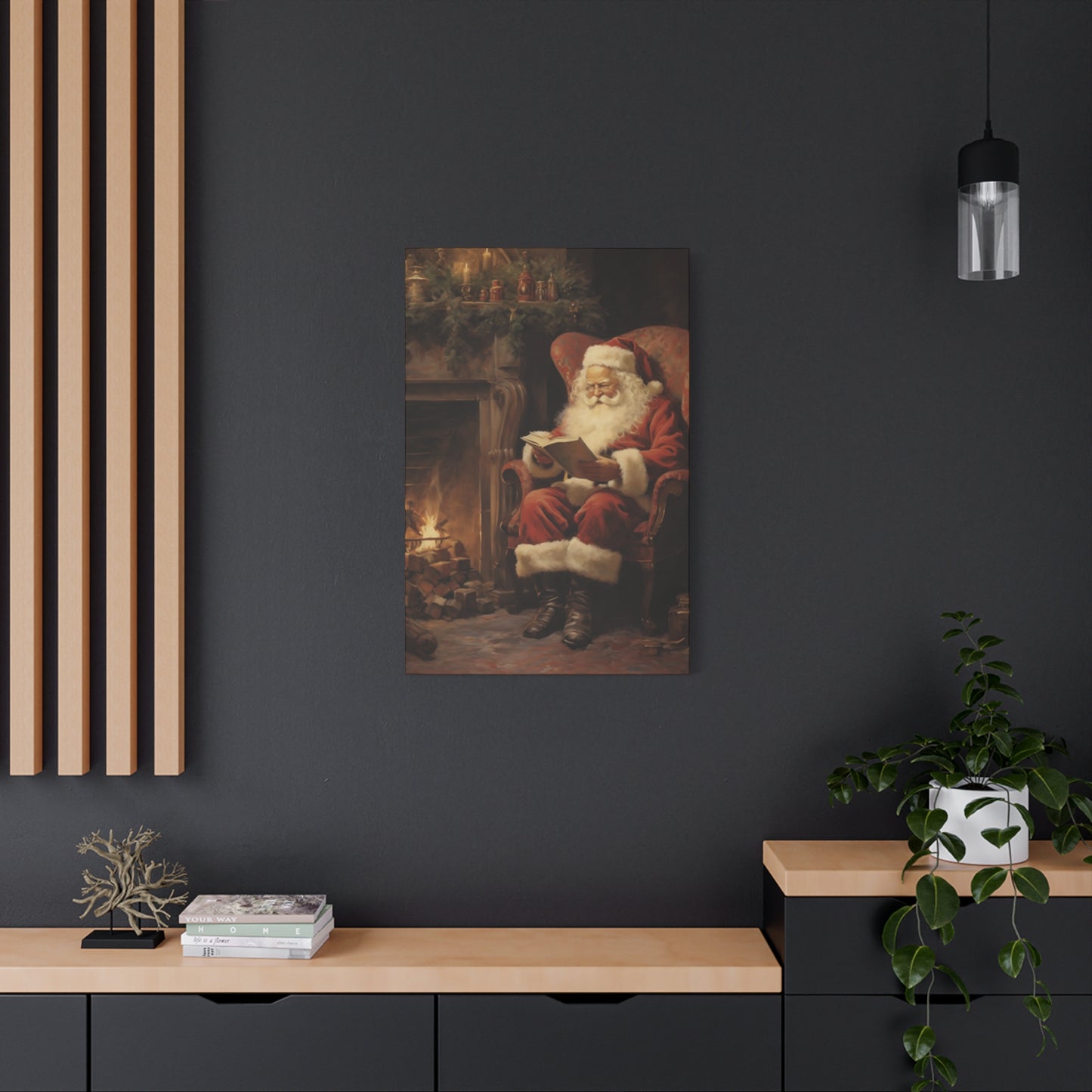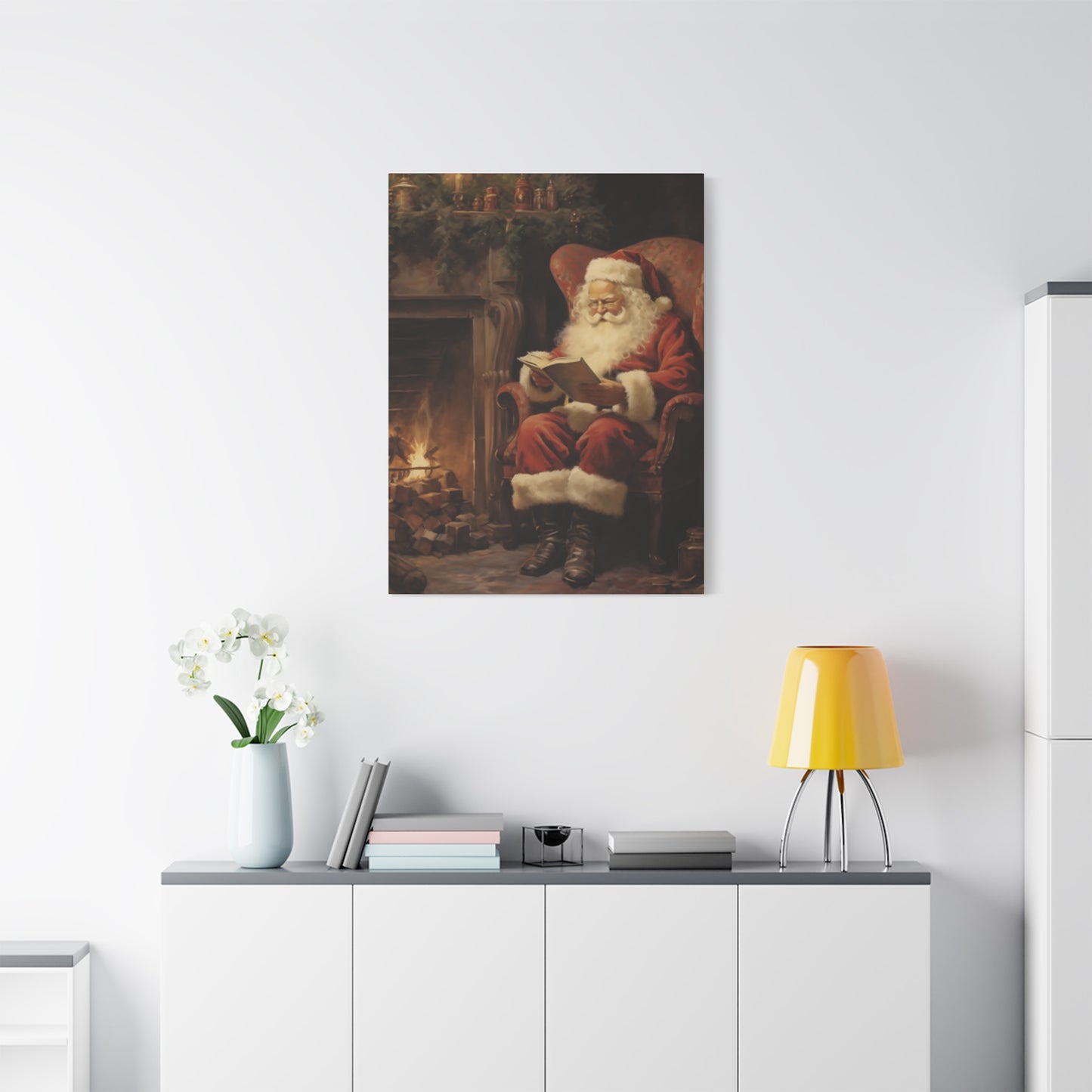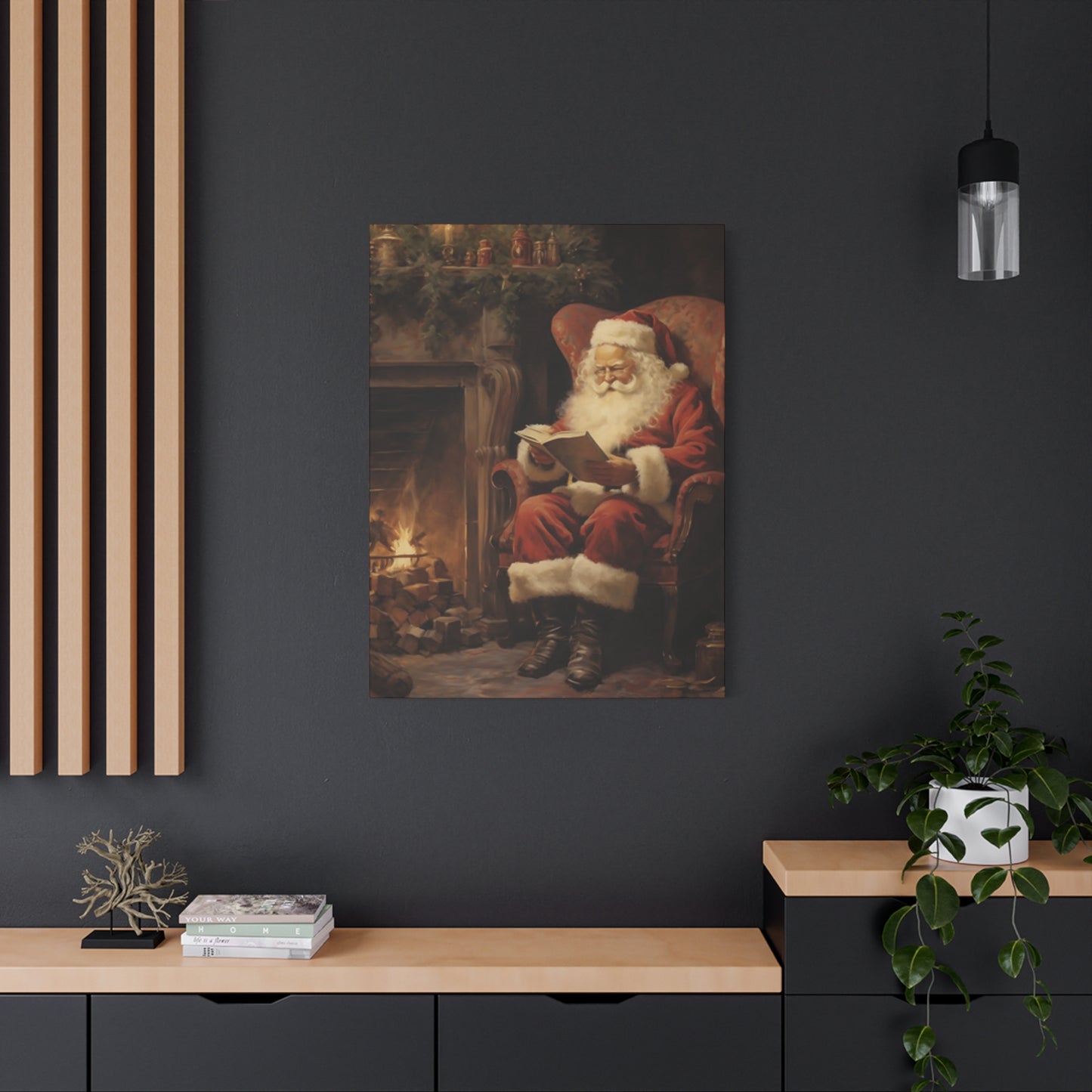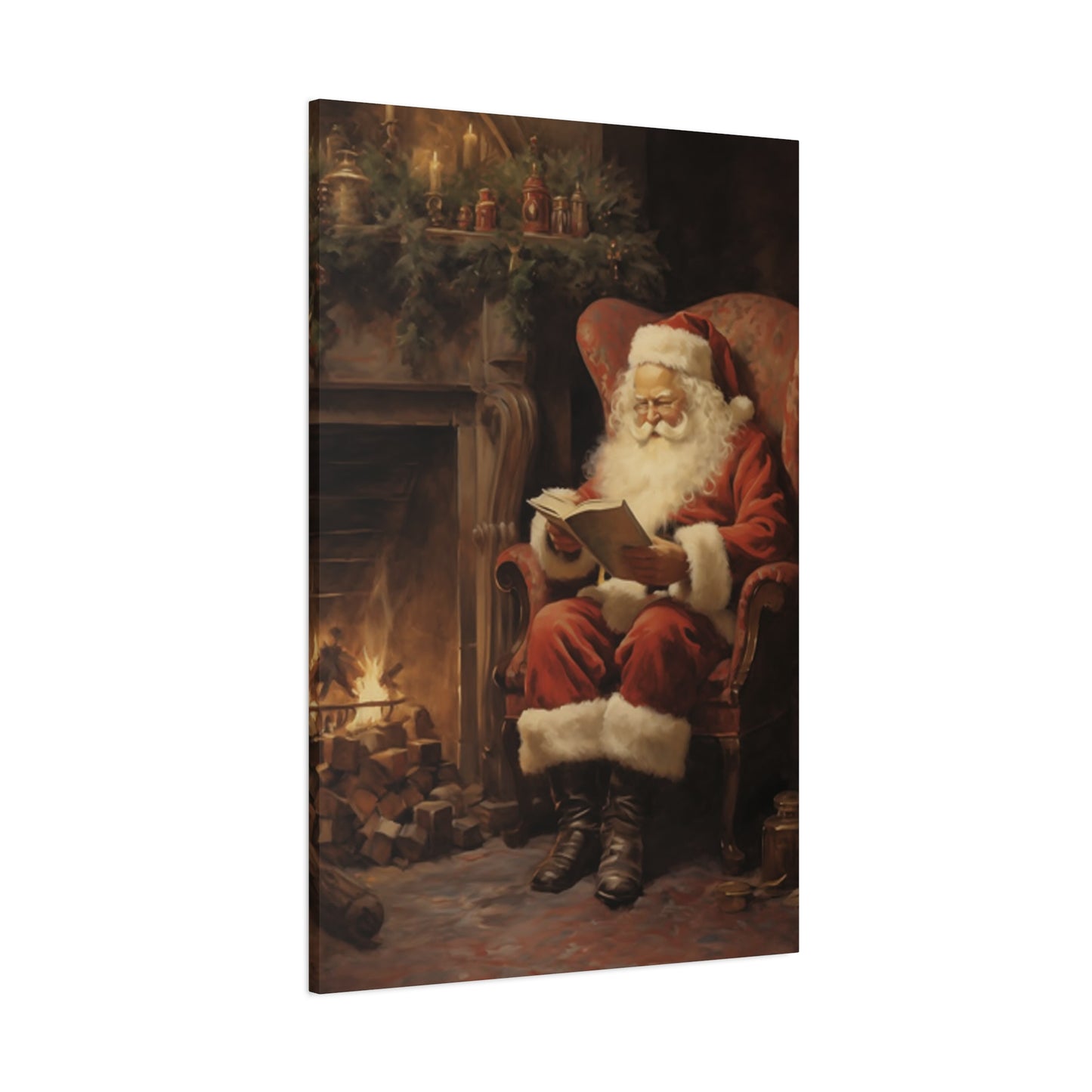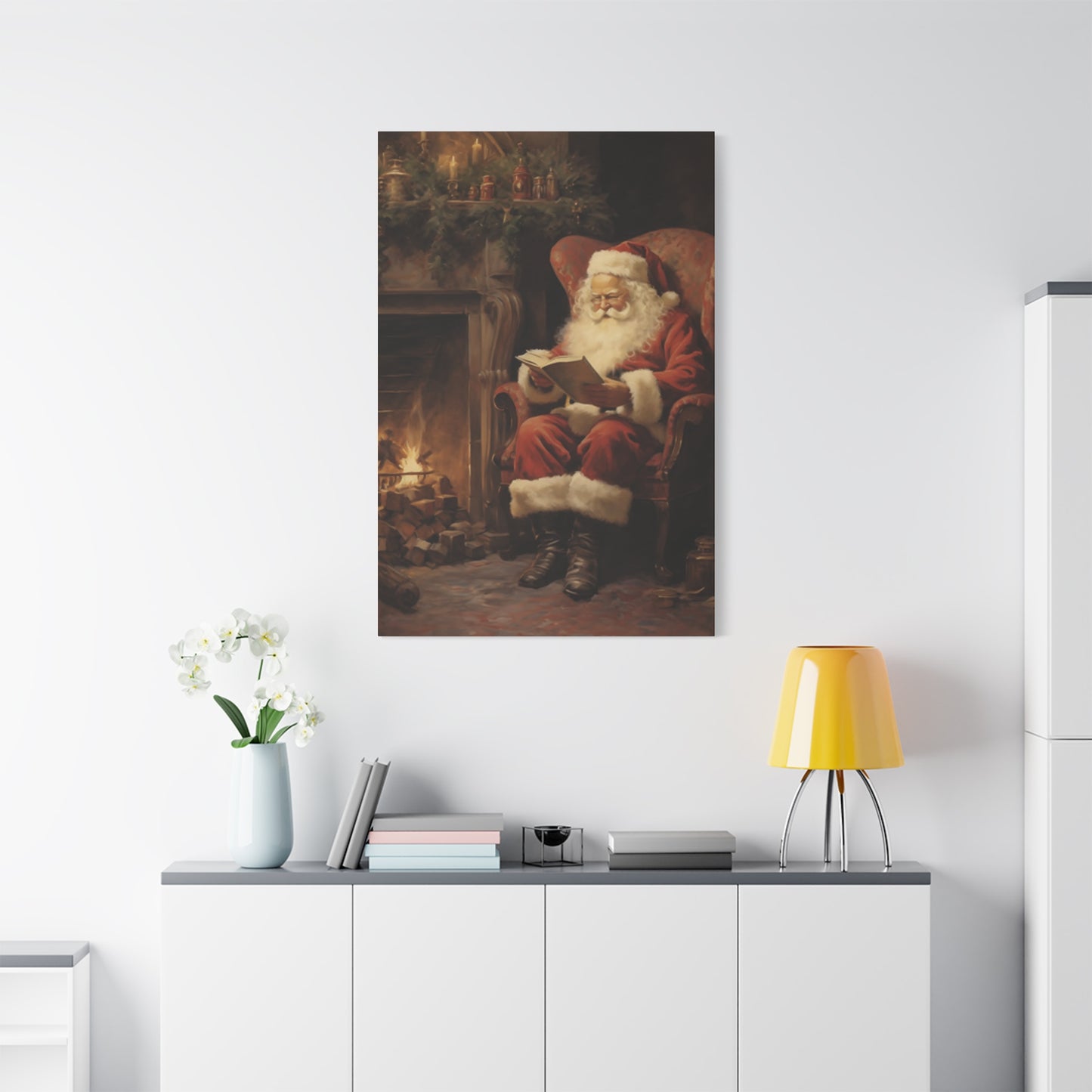Santa Claus Reading a Book Wall Art: A Heartwarming Scene of Holiday Reflection
The tradition of decorating homes with festive imagery has been passed down through generations, creating a sense of warmth and celebration during the holiday season. Wall art featuring Father Christmas engaged in literary pursuits represents a unique intersection of traditional holiday iconography and intellectual sophistication. These decorative pieces capture a quieter, more contemplative side of the beloved Christmas figure, showing him in moments of peaceful reading and reflection. This artistic representation resonates deeply with families who value both holiday traditions and the importance of literacy and learning. The imagery of Saint Nicholas enjoying a good book creates an atmosphere of cozy intellectualism that appeals to book lovers, educators, and families who prioritize reading as a cherished activity. These canvas prints serve multiple purposes in home decoration, functioning as conversation starters, educational tools for children, and beautiful focal points that blend seasonal charm with year-round sophistication.
The Historical Significance of Santa Claus in Art and Literature
Throughout centuries, the figure of Father Christmas has evolved significantly in artistic representations, from the stern medieval gift-bringer to the jolly, rotund character we recognize today. The depiction of this beloved character with books and reading materials adds another dimension to his mythology, emphasizing wisdom, knowledge, and the magic of storytelling. Historically, Saint Nicholas was known as a patron of scholars and students, making the connection between this festive figure and literature particularly appropriate. Artists have long been fascinated by portraying holiday characters in domestic, intimate settings that humanize them and make them more relatable to viewers. When we see Father Christmas absorbed in reading, we connect with the universal experience of losing ourselves in a good story. This artistic choice reflects cultural values about education, leisure, and the importance of quiet contemplation in our busy lives. Canvas prints featuring this theme bridge the gap between traditional holiday imagery and contemporary appreciation for reading culture, creating artwork that feels both nostalgic and relevant to modern sensibilities.
Exploring Different Artistic Styles in Holiday Canvas Wall Decorations
Canvas prints featuring the Christmas gift-bringer engaged in reading come in an extraordinary variety of artistic styles, each offering unique aesthetic qualities and emotional resonances. Traditional realistic paintings capture every detail with photographic precision, showing textures of fur-trimmed suits, the grain of leather-bound books, and the warm glow of firelight. These realistic interpretations appeal to those who appreciate classical art techniques and want their wall decorations to feel authentic and timeless. Watercolor styles bring a softer, dreamlike quality to the imagery, with gentle color transitions and ethereal backgrounds that evoke the magical nature of the holiday season. translucent layers of watercolor create depth and atmosphere, making these prints particularly suitable for nurseries and children's reading nooks. Vintage-inspired illustrations harken back to golden-age Christmas card designs, with muted color palettes, distressed textures, and nostalgic compositions that transport viewers to simpler times. Modern minimalist interpretations strip away unnecessary details, focusing on clean lines, bold color blocks, and simplified forms that work beautifully in contemporary interior designs. Abstract representations push creative boundaries, using symbolic elements, unconventional color schemes, and innovative compositions to reimagine traditional holiday imagery for avant-garde spaces.
Choosing the Perfect Size for Your Wall Art Canvas
Selecting the appropriate dimensions for your festive wall decoration requires careful consideration of multiple factors including wall space, room proportions, viewing distance, and the overall impact you wish to create. Small canvas prints ranging from eight by ten inches to sixteen by twenty inches work beautifully in intimate spaces like reading nooks, home offices, hallway galleries, and children's bedrooms where they can be appreciated up close. These compact sizes also allow for creative grouping arrangements, where multiple related images can be clustered together to create a cohesive gallery wall that tells a visual story.
Medium-sized prints measuring between twenty by thirty inches and thirty by forty inches represent the most versatile option for most residential spaces, providing substantial visual presence without overwhelming the wall or competing with other decorative elements. These proportions work exceptionally well above furniture pieces like sofas, consoles, beds, and fireplace mantels, where they can serve as anchoring focal points. Large-scale canvas prints exceeding forty by sixty inches make dramatic statements in spacious rooms with high ceilings, transforming entire walls into artistic showcases that command attention and create immersive visual experiences. When determining ideal sizing, consider the rule of thirds, which suggests that wall art should occupy approximately two-thirds to three-quarters of the furniture width beneath it to achieve balanced visual harmony.
Color Palette Considerations for Festive Reading-Themed Artwork
The color scheme of your holiday-themed wall decoration profoundly influences the mood, atmosphere, and visual cohesion of your interior space, making careful color selection essential for achieving your desired aesthetic effect. Traditional red and green combinations instantly evoke classic Christmas nostalgia, creating vibrant, energetic displays that celebrate the season with unabashed festivity and joy. These bold color choices work particularly well in family rooms, playrooms, and spaces dedicated to holiday gatherings where you want to maximize seasonal cheer. Warm earth tones including deep browns, rich golds, burnt oranges, and creamy ivories create sophisticated, cozy environments that feel inviting and comfortable while maintaining holiday relevance through subtler seasonal cues.
This palette appeals to those who prefer understated elegance and want artwork that transitions gracefully between seasons without requiring constant rotation. Cool winter palettes featuring icy blues, silver tones, crisp whites, and soft grays evoke the serene beauty of winter landscapes, creating calm, peaceful atmospheres ideal for bedrooms, meditation spaces, and quiet reading areas. These colors pair beautifully with Scandinavian and minimalist design aesthetics, offering holiday spirit without visual overwhelm. Jewel tones such as emerald green, sapphire blue, ruby red, and amethyst purple add luxurious richness to holiday displays, creating opulent, sophisticated looks that elevate ordinary spaces into extraordinary showcases of refined taste and artistic sensibility.
Material Quality and Canvas Construction Techniques
The physical construction and material quality of your festive wall art significantly impact its appearance, longevity, and overall value, making it crucial to understand various manufacturing approaches and quality indicators. Premium canvas prints utilize museum-grade cotton canvas with tight, even weaves that provide smooth surfaces for crisp image reproduction and exceptional color accuracy. These high-quality textiles resist sagging, warping, and deterioration over time, ensuring your investment maintains its beauty for decades. Polyester-cotton blend canvases offer budget-friendly alternatives that still deliver respectable results, though they may not match the longevity and color depth of pure cotton options.
The printing method dramatically affects final quality, with giclée printing representing the gold standard for fine art reproduction, utilizing archival-quality inks and sophisticated color management systems to achieve gallery-worthy results with exceptional detail resolution and color accuracy. UV-resistant inks protect against fading from sunlight exposure, preserving color vibrancy even in rooms with abundant natural light. Gallery wrap construction, where canvas extends around wooden stretcher frame sides, creates finished edges that eliminate the need for additional framing while providing three-dimensional depth and contemporary styling. Mounting options include traditional wooden stretcher bars, which should be kiln-dried and properly braced to prevent warping, and modern aluminum frames that offer lightweight durability and sleek, minimal profiles.
Creating Gallery Walls with Holiday Reading Themes
Designing cohesive gallery wall arrangements featuring multiple pieces of festive literary artwork transforms ordinary walls into curated artistic displays that showcase personality, interests, and aesthetic sensibilities. Successful gallery walls balance variety and unity, incorporating different sizes, orientations, and frame styles while maintaining visual connections through consistent themes, color palettes, or stylistic approaches. When assembling a collection centered on the reading Christmas figure, consider including complementary images such as vintage books, cozy fireplace scenes, winter landscapes, literary quotes, and other holiday characters engaged in quiet activities. This thematic expansion creates richer, more interesting visual narratives while preventing monotony.
Layout planning proves essential for achieving professional-looking results; before committing to nail holes, arrange pieces on the floor or create paper templates to experiment with various configurations. Classic grid arrangements with uniform spacing create orderly, structured looks perfect for modern and traditional interiors alike, while organic, asymmetrical layouts with varied spacing and unexpected juxtapositions feel more relaxed and eclectic. Salon-style gallery walls featuring numerous pieces of varying sizes clustered tightly together create dramatic, maximalist displays that work wonderfully in spaces with abundant wall area. Consider anchoring your arrangement around one large statement piece, then building outward with smaller supporting images that complement and enhance the central focal point.
Incorporating Literary Elements into Holiday Decorating Schemes
Merging bibliophile sensibilities with seasonal celebration creates uniquely sophisticated decorating schemes that honor both intellectual pursuits and festive traditions throughout your living spaces. Canvas artwork depicting the gift-bringing figure surrounded by books naturally complements existing home libraries, reading nooks, study areas, and educational spaces, reinforcing the value your household places on literacy and learning. Enhance this theme by displaying antique books as decorative objects, stacking leather-bound volumes on coffee tables, arranging collections by color for visual impact, and incorporating vintage bookends, reading lamps, and literary-themed accessories throughout your home.
Create dedicated reading corners featuring comfortable seating, adequate lighting, side tables for beverages, cozy throws, and of course, your festive reading-themed wall art positioned where it can be enjoyed during quiet reading sessions. During the holiday season, consider wrapping books in festive paper to serve as decorative elements, stringing garlands made from book pages or literary quotes, and incorporating bookmark ornaments into tree decorations. This approach appeals particularly to educators, librarians, writers, students, and families who want their holiday decorations to reflect their values and interests beyond generic seasonal imagery. The combination of literary and holiday elements creates environments that feel both celebratory and intellectually stimulating, encouraging family reading time and quiet reflection amidst the busy holiday rush.
Placement Strategies for Maximum Visual Impact
Strategic positioning of your festive canvas artwork dramatically influences its effectiveness, visibility, and overall contribution to your interior design scheme, requiring thoughtful consideration of practical and aesthetic factors. Eye-level placement typically positions artwork centers between fifty-seven and sixty inches from the floor, approximating average human eye height in standing positions, ensuring comfortable viewing without neck strain or awkward angles. However, this guideline flexes depending on context; above furniture pieces, artwork should hang four to eight inches above the furniture top to create visual connection while maintaining appropriate separation.
Lighting considerations prove crucial for showcasing your artwork effectively; natural light enhances daytime viewing but may cause fading over time, while artificial lighting offers control and protection. Picture lights, track lighting, or strategically placed lamps can highlight your canvas prints during evening hours, creating warm, inviting atmospheres. Consider sight lines from various room positions, placing artwork where it will be seen and appreciated from frequently occupied areas like seating arrangements, dining tables, and entryways. Avoid hanging valuable artwork in high-humidity areas like bathrooms or directly above heat sources such as radiators and fireplaces, as temperature fluctuations and moisture exposure accelerate deterioration. In children's spaces, consider mounting artwork slightly lower to accommodate shorter viewers, making the imagery more accessible and engaging for young family members who will benefit from seeing the reading role model at their eye level.
Seasonal Rotation Strategies and Year-Round Display Options
Many homeowners grapple with the question of whether festive artwork should be displayed exclusively during holiday seasons or incorporated into year-round decorating schemes, a decision influenced by personal preferences, storage capabilities, and design philosophies. Seasonal rotation approaches treat holiday artwork as special occasion decorations, storing them carefully during off-seasons and rotating them into prominent positions as celebrations approach, creating anticipation and preserving the special feeling associated with holiday traditions. This method works well for highly specific Christmas imagery that feels out of place during other months, allowing you to refresh your spaces periodically with rotating artistic themes that reflect current seasons, holidays, and moods.
Effective storage solutions for rotated artwork include climate-controlled spaces, protective wrapping materials, vertical storage racks that prevent canvas warping, and organizational systems that catalog your collection for easy retrieval. Alternatively, year-round display strategies emphasize the universal themes present in reading-focused holiday artwork, namely literacy, coziness, wisdom, and quiet reflection, which remain relevant regardless of season. By selecting artwork with subtle seasonal references, muted color palettes, or winter themes rather than explicit holiday symbols, you create decorations that transition gracefully throughout the year. Many collectors compromise by maintaining permanent gallery walls where holiday pieces rotate in and out among constant year-round artwork, refreshing the display without completely dismantling it. This balanced approach satisfies both the desire for seasonal celebration and the practical preference for stable decorating schemes.
Customization Options for Personalized Holiday Artwork
Personalized canvas prints transform generic holiday decorations into meaningful, one-of-a-kind treasures that reflect individual families, stories, and traditions, creating emotional connections that mass-produced artwork cannot replicate. Custom text additions allow incorporation of family names, favorite quotes, meaningful dates, children's names, or special messages that personalize the artwork and increase its sentimental value. Imagine a festive reading scene captioned with your family surname, a beloved literary quote from your favorite author, or the year your family began a special holiday tradition. Color customization enables matching artwork precisely to existing interior color schemes, ensuring perfect coordination with wall paint, furniture upholstery, accent colors, and other decorative elements in your space.
Many printing services offer color consultation, providing digital proofs and samples to ensure satisfaction before final production. Size adjustments accommodate specific wall dimensions and spatial requirements, whether you need an unusually narrow vertical piece for a tight hallway or an oversized horizontal canvas for an expansive blank wall. Composite imagery allows combining the literary Christmas figure with family photographs, favorite book covers, meaningful locations, or other personal elements, creating truly unique artwork that tells your specific story. Some services even offer hand-painted enhancements, where artists add texture and dimension to printed canvases, elevating them beyond standard reproductions into unique art pieces. Pet portrait integration provides particularly delightful customization, depicting family pets alongside the reading holiday figure, creating whimsical, personalized scenes that celebrate beloved animal companions.
Budget Considerations and Value Assessment
Investing in quality canvas artwork requires balancing budget constraints with desires for beauty, durability, and appropriate value, understanding that price variations reflect significant differences in materials, craftsmanship, and longevity. Entry-level options starting around twenty to fifty dollars typically feature digital printing on polyester-cotton blend canvases with basic wooden frames, offering acceptable appearance for temporary or casual displays but potentially lacking longevity and color accuracy for permanent installations. Mid-range selections priced between seventy-five and two hundred dollars generally provide better quality materials, including higher cotton content canvases, improved printing technology, better color management, and sturdier frame construction that justifies the increased investment through enhanced appearance and durability.
Premium offerings exceeding three hundred dollars incorporate museum-quality materials, giclée printing processes, archival inks, custom sizing, hand-finishing touches, and superior frame construction that positions them as genuine art investments rather than disposable decorations. When assessing value, consider cost-per-year rather than initial price; a two-hundred-dollar canvas lasting twenty years provides far better value than a fifty-dollar version requiring replacement every few years due to fading or deterioration. Sales, promotional periods, and holiday discounts offer opportunities for securing quality pieces at reduced prices, with many retailers offering significant savings during off-season periods when demand drops. Consider starting with one high-quality statement piece rather than multiple lower-quality items, gradually building your collection over time as budget allows. Handmade or artist-created pieces command higher prices but offer unique qualities, supporting individual artists while acquiring truly distinctive artwork unavailable through mass-market channels.
Benefits for Children and Family Learning
Displaying imagery of the beloved Christmas character engaged in reading provides subtle but powerful educational messaging that reinforces literacy values and promotes positive reading attitudes among children and family members. Visual role models significantly influence child development, and seeing a figure they admire portrayed as a reader normalizes and celebrates this activity, potentially increasing children's intrinsic motivation to read. This positive association between holidays, gift-giving, and reading may encourage children to view books as desirable gifts and reading as an enjoyable activity rather than an obligation or chore. Family discussions about the artwork create opportunities for conversations about favorite books, storytelling traditions, the importance of lifelong learning, and why people throughout history have valued reading.
Parents can leverage the imagery to establish holiday reading traditions, such as reading one holiday story each evening while sitting near the artwork, creating multi-sensory experiences that embed positive reading memories. For younger children still developing literacy skills, the artwork serves as environmental print, surrounding them with images that connect to literacy even before they can read independently. Older children might appreciate the irony or humor in imagining the busy gift-bringer taking time to read, leading to discussions about work-life balance, the importance of rest, and making time for activities we enjoy. Educational settings including school libraries, classrooms, tutoring centers, and literacy programs particularly benefit from such decorations, creating environments that celebrate reading through multiple visual and cultural touchpoints that reinforce educational messaging beyond direct instruction.
Matching Canvas Prints to Interior Design Styles
Successfully integrating festive reading artwork into existing interior design schemes requires understanding various decorating styles and selecting pieces that complement rather than contradict your established aesthetic language. Traditional interiors featuring classic furniture, rich wood tones, ornate details, and formal arrangements pair beautifully with realistic or vintage-style artwork that reflects historical artistic techniques and nostalgic sensibilities. These spaces can accommodate bolder colors and more detailed imagery without creating visual conflict. Modern design emphasizing clean lines, minimal ornamentation, neutral color palettes, and uncluttered spaces calls for simplified artistic interpretations with limited color palettes, substantial negative space, and contemporary framing approaches such as frameless mounting or sleek metal frames.
Farmhouse and rustic styles characterized by reclaimed wood, distressed finishes, natural materials, and cozy textures work wonderfully with vintage-inspired or folk-art style representations that embrace imperfection and handcrafted qualities. Scandinavian interiors prioritizing simplicity, functionality, natural light, and muted colors benefit from artwork featuring cool color palettes, minimal details, and winter landscape elements that align with Nordic aesthetic principles. Eclectic and bohemian spaces that celebrate personality, mix patterns and colors, and embrace collected-over-time aesthetics can accommodate virtually any artistic style, using the contrast and variety as design features rather than problems to solve. Mid-century modern environments with their distinctive furniture silhouettes, geometric patterns, and retro color schemes pair well with illustration-style artwork that references golden-age commercial art and graphic design approaches from the same historical period.
Digital Printing Technologies and Quality Comparisons
Understanding various printing technologies helps consumers make informed decisions about canvas quality, expected longevity, and appropriate price points for their holiday artwork investments. Giclée printing represents the highest standard in digital reproduction, utilizing sophisticated inkjet technology with expanded color gamuts typically involving seven to twelve individual ink colors rather than standard four-color processes. This expanded palette achieves superior color accuracy, subtle gradations, and exceptional detail resolution that closely approximates original artwork. The term giclée derives from French, roughly translating to sprayed or squirted, describing the fine mist of archival inks applied to museum-quality canvas substrates. These prints, when properly executed with archival materials, carry longevity ratings exceeding one hundred years under proper display conditions, justifying premium pricing for collectors and those seeking genuine art quality.
Standard digital printing employs CMYK four-color processes suitable for most decorative applications, delivering acceptable color reproduction and detail at more accessible price points, though with somewhat reduced longevity and color depth compared to giclée processes. Dye-based inks provide vibrant colors and smooth gradations but prove more susceptible to fading from UV exposure, making them less suitable for spaces with abundant natural light. Pigment-based inks offer superior lightfastness and longevity, maintaining color integrity decades longer than dye-based alternatives, representing the preferred choice for archival-quality reproductions. Resolution specifications significantly impact final image quality, with higher DPI ratings producing crisper details, smoother curves, and more accurate reproduction of fine elements; look for minimum 300 DPI specifications for quality results. Color management systems ensure consistency between digital files and printed output, crucial for achieving expected results rather than disappointing color shifts or inaccuracies.
Frame and Mounting Alternatives for Diverse Aesthetics
Beyond traditional gallery-wrap canvas construction, numerous framing and mounting options allow customization of your festive reading artwork to match personal preferences, budget constraints, and specific interior design requirements. Floating frames create contemporary presentations where canvas appears suspended within frame boundaries, generating shadow gaps that add dimensional interest and modern sophistication. These frames, typically constructed from wood or metal, surround canvas edges without touching the face, protecting while showcasing. Traditional wood frames with ornate molding details suit classical interiors, adding formal presentation that elevates canvas prints to fine art status. Frame finishes range from natural wood grains and distressed vintage textures to painted colors and metallic leafing, offering extensive customization potential.
Metal frames provide sleek, minimalist alternatives particularly appropriate for modern and industrial design schemes, available in various finishes including brushed aluminum, matte black, polished chrome, and antiqued bronze. Shadowbox framing incorporates dimensional space between artwork and protective glazing, allowing incorporation of three-dimensional elements like dried flowers, small ornaments, or other objects that enhance thematic presentation. Frameless mounting systems using standoff hardware create ultra-modern floating appearances where artwork projects from walls without visible support mechanisms, generating clean, gallery-like presentations. For rental situations or those preferring non-permanent installations, adhesive hanging strips provide damage-free mounting that protects walls while securing artwork firmly. Easel displays offer portable alternatives for seasonal rotations, allowing easy relocation and storage without wall mounting requirements, particularly useful for tabletop and mantel presentations.
Caring for and Maintaining Canvas Wall Art
Proper maintenance and care practices significantly extend the lifespan and appearance of your festive canvas artwork, protecting your investment while ensuring continued enjoyment for years or decades to come. Dust accumulation represents the primary maintenance concern for canvas prints, as particles settle into textile weaves, dulling colors and creating grimy appearances over time. Regular gentle dusting using soft, dry microfiber cloths prevents buildup without damaging printing or canvas surfaces; dust monthly or more frequently in high-traffic areas or dusty environments. For more thorough cleaning when dust cloths prove insufficient, very lightly dampened soft cloths can remove stubborn grime, but water should be used extremely sparingly to avoid saturating canvas or damaging inks.
Never use cleaning chemicals, glass cleaners, or abrasive materials on canvas prints, as these damage printing and textile fibers. Protect artwork from direct sunlight exposure, which fades colors over time regardless of ink quality; UV-protective glazing or window films on nearby windows help mitigate damage in bright rooms. Maintain stable environmental conditions avoiding extreme temperature fluctuations, high humidity, or excessive dryness, all of which stress canvas materials and accelerate deterioration. In humid climates or damp spaces, monitor for mold or mildew development, removing artwork immediately if issues arise and addressing underlying moisture problems before rehanging. Periodically inspect mounting hardware for security, tightening any loose screws or brackets before artwork risks falling and sustaining damage. When storing rotated seasonal pieces, wrap canvases in acid-free tissue or breathable fabric rather than plastic, which can trap moisture and promote mold growth, and store flat or carefully standing to prevent warping or stress to stretched canvas.
Supporting Independent Artists and Small Businesses
Purchasing festive reading-themed artwork from independent artists and small creative businesses rather than mass-market retailers provides numerous benefits extending beyond simple transactions into meaningful support of creative communities. Independent artists bring unique perspectives, original styles, and personal craftsmanship to their work, creating truly distinctive pieces unavailable through corporate channels that rely on mass-produced, market-tested designs. When you purchase from individual creators, your money directly supports working artists, enabling them to continue creating, developing their skills, and contributing to cultural richness. Small businesses typically offer superior customer service, customization flexibility, and willingness to accommodate special requests that large corporations cannot match due to scale and standardization.
Many independent artists welcome commission work, creating completely custom pieces tailored to your exact specifications, color preferences, size requirements, and thematic desires. This personalized approach results in artwork perfectly suited to your specific needs rather than compromising with close-enough mass-market alternatives. Online marketplaces, craft fairs, local art galleries, and artist websites provide numerous channels for discovering and connecting with talented creators whose work resonates with your aesthetic sensibilities. Building relationships with artists whose style you appreciate may lead to ongoing collecting opportunities, early access to new work, and connections to broader creative communities. Social media platforms enable direct artist engagement, allowing you to understand their creative processes, inspirations, and stories behind their work, adding meaningful context and depth to your art ownership experience. From a sustainability perspective, independent artists frequently employ more environmentally conscious practices, using eco-friendly materials, local production, and thoughtful approaches that minimize waste compared to industrial mass production.
Holiday Traditions and Family Storytelling Opportunities
Festive canvas artwork depicting literary scenes creates natural opportunities for establishing meaningful family traditions and storytelling rituals that enrich holiday celebrations beyond material gift exchanges. Consider unveiling new artwork pieces as part of annual traditions, perhaps revealing them on specific dates like the beginning of December, creating anticipation and marking the official start of your family's holiday season. Gather family members for special reading sessions positioned near your holiday artwork, selecting books that complement the themes of wisdom, coziness, and storytelling represented in the imagery. These dedicated reading times model literacy values while creating peaceful moments of connection amidst hectic holiday preparations. Encourage children to create their own stories inspired by the artwork, imagining what the character might be reading, inventing tales about how even busy gift-bringers make time for books, or developing narratives about favorite holiday memories.
This creative exercise develops literacy skills, imagination, and personal expression while engaging with your home decorations in meaningful ways. Photograph family members posed near holiday artwork annually, creating visual records that document growth and changes over years, eventually compiling these images into albums or montages that become treasured family artifacts. Some families establish traditions of reading the same special book each year while sitting near their holiday reading artwork, creating multi-sensory memory anchors that weave together visual, auditory, and emotional experiences into powerful nostalgic associations. Consider writing dates, family milestones, or special memories on canvas backs, creating hidden records that future generations might discover, connecting them to family history and the people who came before. These practices transform decorative objects into meaningful family touchstones that carry significance beyond their aesthetic contributions.
Cultural Variations in Holiday Character Representations
The figure of the gift-bringing Christmas character manifests differently across global cultures, and understanding these variations enriches appreciation for diverse artistic representations found in canvas wall art. American traditions portray him in red suits with white fur trim, influenced heavily by early twentieth-century commercial advertising, particularly famous campaigns that standardized the appearance now recognized worldwide. This version emphasizes joviality, generosity, and magical overnight gift delivery, creating the template most commonly referenced in contemporary artwork. European traditions maintain regional variations, with Father Christmas in England taking on slightly different characteristics than the American version, often portrayed in green robes in historical depictions rather than exclusively red. Dutch Sinterklaas celebrations feature a more solemn religious figure arriving by steamboat from Spain, wearing bishop's robes and accompanied by helpers, representing a more historically grounded interpretation of Saint Nicholas traditions.
German Weihnachtsmann and French Père Noël carry their own cultural distinctions in appearance and associated traditions. Scandinavian countries maintain unique characters like Sweden's Jultomten or Denmark's Julemanden, often portrayed with more elf-like or gnome-like qualities reflecting Nordic folklore. These cultural variations provide rich source material for artists creating holiday-themed work, offering alternatives to standardized commercial imagery. Canvas prints reflecting these diverse traditions appeal to multicultural households, expatriates maintaining connections to heritage cultures, and those simply appreciating the breadth of global holiday traditions. Artistic representations incorporating books and reading transcend specific cultural interpretations, emphasizing universal human values around knowledge, storytelling, and contemplation that resonate across traditions.
Environmental Sustainability in Canvas Print Production
Increasingly, consumers prioritize environmental sustainability when making purchasing decisions, including selections of decorative artwork, driving industry changes toward more eco-conscious production methods and materials. Sustainable canvas options include organic cotton grown without synthetic pesticides or fertilizers, reducing environmental impact and chemical exposure for farmworkers. Bamboo-based textiles offer rapidly renewable alternatives to traditional cotton, with bamboo plants growing quickly without requiring replanting, pesticides, or extensive irrigation. Recycled polyester fabrics manufactured from post-consumer plastic bottles divert waste from landfills while creating serviceable canvas substrates, though they may not match cotton's archival qualities. Water-based inks eliminate or dramatically reduce volatile organic compounds found in traditional solvent-based formulations, improving air quality in production facilities and reducing environmental releases.
Some manufacturers achieve carbon-neutral production through renewable energy use, efficiency improvements, and offset programs that balance emissions. Sustainable wood for stretcher frames should come from responsibly managed forests certified by organizations monitoring forest health, biodiversity, and fair labor practices. Local or domestic production reduces transportation emissions while supporting regional economies, though this advantage depends on relative production practices. Minimal packaging using recycled or recyclable materials, avoiding excessive plastic, and utilizing biodegradable void fill demonstrates commitment to reducing waste throughout the supply chain. Some progressive companies offer take-back programs for damaged or unwanted artwork, recycling or responsibly disposing of materials rather than consigning them to landfills. Conscious consumers should research company practices, looking for transparent disclosure of materials and processes, third-party certifications, and genuine commitment to improvement rather than superficial greenwashing marketing claims.
Conclusion:
The decision to incorporate canvas prints featuring Father Christmas engaged in reading represents far more than simple decoration choices; it reflects values, creates atmosphere, tells stories, and contributes to the complex tapestry of elements that transform houses into homes filled with meaning, beauty, and personal expression. These artistic pieces successfully bridge multiple worlds, honoring beloved holiday traditions while celebrating literacy, learning, and the quiet pleasures of reading that enrich lives throughout the year. The imagery provides visual interest and focal points that anchor room designs while remaining flexible enough to complement diverse interior styles from traditional to contemporary, rustic to minimalist. Beyond aesthetic contributions, such artwork serves educational purposes, modeling reading behavior for children, reinforcing family values around literacy, and creating environmental cues that books and learning deserve honored places in our homes and lives.
The selection process itself becomes an enjoyable exploration of artistic styles, size considerations, color palettes, and quality factors that deepen understanding of both art and interior design principles. Whether you choose realistic depictions that capture every detail, whimsical illustrations that spark imagination, vintage styles that evoke nostalgia, or modern interpretations that push creative boundaries, your choices reflect personal taste and contribute to creating spaces that feel authentically yours. The rituals and traditions that develop around your holiday artwork, from annual unveiling ceremonies to special reading sessions to photographic documentation, layer additional meaning onto these decorative objects, transforming them into family touchstones that accumulate emotional significance with each passing year. Investment in quality materials and thoughtful production methods ensures these pieces maintain their beauty and integrity for decades, potentially becoming treasured items passed down through generations, carrying stories and memories forward in time.
Supporting independent artists and small businesses when acquiring your artwork extends benefits beyond your household, contributing to creative communities and enabling artists to continue producing the distinctive, heartfelt work that enriches our visual culture. As you contemplate wall spaces waiting for that perfect piece, consider how imagery combining holiday magic with literary celebration might contribute not just decoration but genuine enrichment to your daily environment, quietly reminding you and your loved ones that amidst busy schedules and endless obligations, making time for stories, learning, and quiet contemplation remains among life's greatest and most accessible pleasures, worth celebrating every day of the year.

















